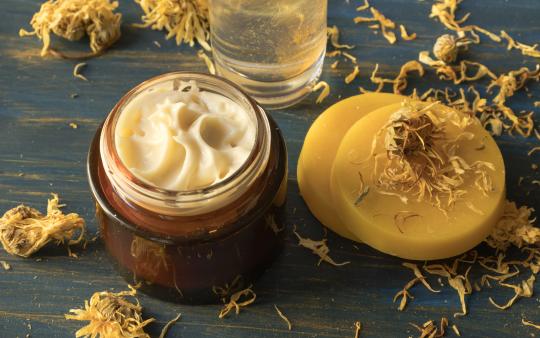In a world of products promising intense moisturizing, smoothing, and soothing, it can be hard to choose which one is actually good for your skin when so many contain impossible-to-pronounce, yet very authoritative-sounding ingredients like amodimethicone, cyclomethicone, dimethicone, methicone, trimethicone or trimethylsilylamodimethicone. What do all these have in common? They’re silicone. And you may be slathering it on your skin without knowing it!
The science of silicone
Silicone (and silicone variants) started their lives as naturally occurring silicon, the second-most abundant element in the Earth's crust, after oxygen. When combined with oxygen, silicon forms silica (or silicon dioxide)—what we recognize as quartz—the most common component of sand.
In order to produce silicone, the silicon derived from quartz is exposed to a series of chemical reactions to create polysiloxanes. Heat-resistant and extremely stable, they come in the form of a liquid, semi-solid adhesive, or flexible rubber-like material, and are used in such things as sealants, adhesives, lubricants, medicine, cooking utensils, and electrical insulation. And because these compounds can be successfully linked together into a very stable thin liquid, silicone is a perfect medium for filling wrinkles and smoothing skin. To put silicone’s strange suitability in beauty products into perspective: its first notable debut into mainstream life was as Silly Putty.
Unmasking silicone's appeal
If you’ve been trying to clean up your skincare routine and have taken to the web to find out which ingredients to avoid, you’ll know it’s rough out there. The “silicone is good”’ versus “silicone is bad” camps are uncompromising in their campaigns to champion for the triple crown of soft, glowing, flawless skin. While silicone does give things like your hair and skin and, well, your baking sheet, a silky texture, a major factor in why it’s used in beauty products is pretty coarse: it’s cheap—far cheaper than it is to use the more costly, naturally occurring materials that can also seal in moisture, smooth your skin, and give your hair a lustrous sheen and feel. With their longer shelf life and budget-friendly ingredients, synthetic silicone products often win over their natural counterparts. But for a moment, consider the Twinkie that often features as a survivalist staple in post-apocalyptic dystopian fictions and compare it to a fresh, juicy, though ephemeral, apple—it’s a no-brainer which is better packed in your lunch!
Face Food
Let your tummy be your plant-based guide on your next trip down the skincare aisle!
- Seal in moisture with beeswax, carnauba wax, candelilla wax, oils like olive, avocado, rice bran, macadamia, castor, and soybean, and shea and cocoa butters.
- Smooth skin with sweet almond, sesame, olive, and argan oils, and butters from shea and cocoa.
Silcone is safe(-ish)
A small victory for the pro camp, silicones have been generally labelled as low-hazard for humans with both the FDA and Environment Canada deciding no action is so far needed to limit their use in cosmetics. However, though most of the polymers assessed by an independent panel of Canadian scientists were deemed not to meet the criteria for further investigation, there remains a big question mark on those findings: David Suzuki puts siloxane on his hit list of Dirty Dozen ingredients to avoid, and by 2020, Europe will prohibit the use of octamethylcyclotetrasiloxane (D4) and decamethylcyclopentasiloxane (D5) in cosmetics intended to be washed off after use.
Silicone sticks (around)
Silicones are great at being waterproof and retaining moisture. They help colour stay put and give skincare products that silky feel. They don’t tug at skin while swiping on deodorant and they keep sunscreens, makeup, and creams on our skin, even when we sweat! But silicone’s waterproof nature creates something of a conundrum when introduced to, say, your bathroom sink, or, the ocean. Once it’s been washed off your skin, where does it go? Spoiler alert: back to you, through the unnerving magic of bioaccumulation. Over the years many studies have been done, including one in Europe, that have found detectable levels of siloxane in fish and one done recently that discovered some of the nanomaterial accumulated was double-coated in dimethicone (also called polymethylsiloxane, a silicon-based polymer used as a lubricant and conditioning agent).
While the Canadian scientists found that silicones were “entering the environment in a quantity or concentration or under conditions that would have an immediate or long-term harmful effect on the environment or its biological diversity” they also found they were not “entering the environment in a quantity or a concentration or under conditions that constitute or may constitute a danger in Canada to human life or health” and the aforementioned studies add another question mark to a murky situation. Other studies have found instances of free particles of silicates on the surface of silicone joint and prosthetic implants, and also in the lymph nodes of the wearer, and a number of kidney dialysis patients whose treatment involved silicone tubing were found to have liver disease, indicating that the government-assured safety of silicone is certainly open for more discussion.
Silicone works (for now)
Here’s the most ironically problematic thing about silicone in beauty products: it works. At least temporarily. If you want smooth-looking skin that appears wrinkle- and blemish-free, then silicone has got you smothered—er—covered. But that mask comes with a price. Silicone is simply giving the appearance of smooth skin or shiny hair, it’s not actually improving hair or skin’s texture, or reducing fine lines—it’s coating and filling them in with product until you wash it down the drain and into the ecosystem.
While the jury is still officially out as to whether silicones in cosmetics are just ho-hum or wreaking havoc, the simple fact is, if you wouldn’t eat it, you should wonder whether you want your body absorbing it. (Mind you, dimethicone has been found in chicken nuggets, so you probably shouldn’t eat those either!) Furthermore, if an ingredient isn’t actually improving the health and longevity of your skin, but is just masking it, why not opt instead for skin care products that look and feel good, and improve it?
We’ve all heard beauty starts on the inside, and it’s true. Eating well, getting enough water, supplementing when necessary, exercising, getting enough sleep, and minimizing stressors are all key to great skin. Add to that choosing a quality skincare regimen with ingredients that you can pronounce, and safely eat for dinner, and you’re well on your way to battling seasonal skin assaults!






